
Orangeville is a village in Stephenson County, Illinois, United States. The town's sign lists the population at 800 as of January 2021. The population in 2020 was 738. The population according to the 2010 census was 793, up from 751 in 2000. Using the 2020 population of 738 Orangeville is the 741st largest city in Illinois and the 11,650th largest city in the United States. Orangeville is currently declining at a rate of -0.94% annually and its population has decreased by -6.94% since the 2010 census. The area's earliest white settlers arrived in the year 1833, and the village was platted in 1851 by John Bower, who is considered the village founder. In 1867 Orangeville was incorporated as a village. The town's central business district contains several 19th century commercial buildings, many of which were built during the railroad boom of 1888–1914. By the time the Great Depression was ongoing, business in Orangeville had started to decline, with the last bank closing in 1932. In 1956 another bank started operating in the village and is still in town today. Some recent infrastructure jumps have restored some of the village's old decor.

The University of Wisconsin Oshkosh is a public university in Oshkosh, Wisconsin. It is part of the University of Wisconsin System and offers bachelor's, master's, and doctoral degree programs to around 14,000 students each year.

The First Unitarian Society of Madison (FUS) is a Unitarian Universalist congregation in Shorewood Hills, Wisconsin. Its meeting house was designed by Frank Lloyd Wright and built by Marshall Erdman in 1949–1951, and has been designated a U.S. National Historic Landmark for its architecture. With over 1,000 members, it is one of the ten largest Unitarian Universalist congregations in the United States.
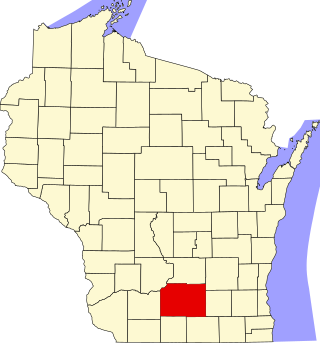
This is a list of the National Register of Historic Places listings in Dane County, Wisconsin. It aims to provide a comprehensive listing of buildings, sites, structures, districts, and objects in Dane County, Wisconsin listed on the National Register of Historic Places.
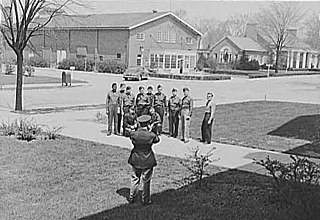
Fort Benjamin Harrison was a U.S. Army post located in suburban Lawrence Township, Marion County, Indiana, northeast of Indianapolis, between 1906 and 1991. It is named for the 23rd United States president, Benjamin Harrison.

Central House is an 1860s hotel building located in the 800-person village of Orangeville, in Stephenson County, Illinois, United States. The building was built by Orangeville founder John Bower and operated as a hotel from its construction until the 1930s, when it was converted for use as a single family residence. The three-story building was the first commercial brick structure in downtown Orangeville. Architecturally, the building is cast in a mid-19th-century Italianate style. Central House was added to the U.S. National Register of Historic Places in 1999.
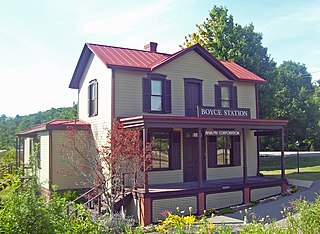
Boyce is a disused train station located at the junction of Boyce Road and the tracks of the Chartiers Branch in Upper St. Clair, Pennsylvania, United States. It was built in 1900, and housed not only the rail operations but a post office and general store for the small community it served.

The Danes Hall in Waupaca, Wisconsin, United States, was built in 1894 as a gathering place for the Danes Home Society. It served historically as a clubhouse, as a meeting hall, and as an auditorium. The upper floor consists of a dance hall with a balcony. It was listed on the National Register of Historic Places in 1980.
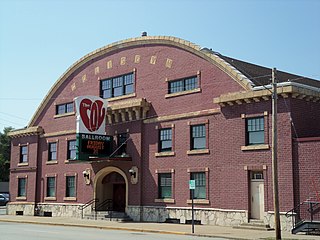
The Col Ballroom is a historic building located in the West End of Davenport, Iowa, United States. It was listed on the National Register of Historic Places and on the Davenport Register of Historic Properties as the Saengerfest Halle.
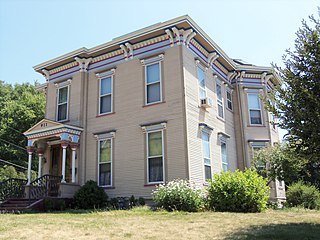
The James E. Lindsay House is a historic building located on the east side of Davenport, Iowa, United States. It has been listed on the National Register of Historic Places since 1984.
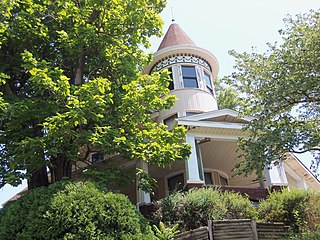
The Lewis M. Fisher House is a historic building located on the east side of Davenport, Iowa, United States. It has been listed on the National Register of Historic Places since 1983.

The George Copeland House is a historic building located on the east side of Davenport, Iowa, United States. The residence has been listed on the National Register of Historic Places since 1984.

The John W. Ballard House is a historic building located in central Davenport, Iowa, United States. It has been listed on the National Register of Historic Places since 1983.

The Dr. Heinrich Matthey House is a historic building located in the Hamburg Historic District in Davenport, Iowa, United States. The district was added to the National Register of Historic Places in 1983. The house was individually listed on the Davenport Register of Historic Properties in 1993.

Daleyville is an unincorporated community located in the town of Perry, Dane County, Wisconsin, United States.

Heiney's Meat Market, also known as Corodonn's Meat Market Restaurant, is a former meat market and adjacent house located in the town of Black Earth, Wisconsin. The initial house was built in 1869, with later additions, and added to the National Register of Historic Places in 1984.

Porter Hall is a historic residence located in Centerville, Iowa, United States. The 2½-story frame house exhibits aspects of the Picturesque Tudor Revival style, especially in the half-timbering and stucco. The house gained its present appearance during the ownership of Dr. Charles James in the 1910s and 1920s. There is some question as to whether this is an older 1880s house that has been extensively remodeled. It receives its name from Claude R. Porter who owned this property from 1906 to 1909. Porter was a Democrat, who served two terms in the Iowa House of Representatives, two terms in the Iowa Senate, United States Attorney for the Southern District of Iowa, and a member of the Interstate Commerce Commission. He was also a perennial candidate for Governor of Iowa and the U.S. Senate from Iowa, but lost every election to his Republican opponent. The house was listed on the National Register of Historic Places in 1980.

The Charles Henry Parr House is a historic building located in Charles City, Iowa, United States. It was listed on the National Register of Historic Places in 1980. The 2½-story, vernacular frame structure was completed in 1902.
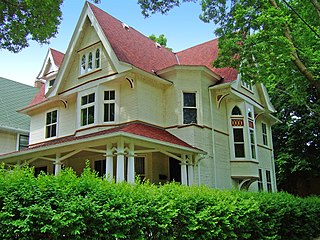
The Bascom B. Clarke House in Madison, Wisconsin was built in 1899, designed in Queen Anne style with Gothic Revival details for Clarke, who founded the magazine American Thresherman. In 1980 it was added to the National Register of Historic Places.

Bowerstown is an unincorporated community in Washington Township, Warren County, New Jersey near the Morris Canal and the Pohatcong Creek. It was founded in 1829 by Jesse Vanetta and Michael B. Bowers with the building of an iron foundry. The Bowerstown Historic District, encompassing the village, was listed on the state and national registers of historic places in 1996.





















